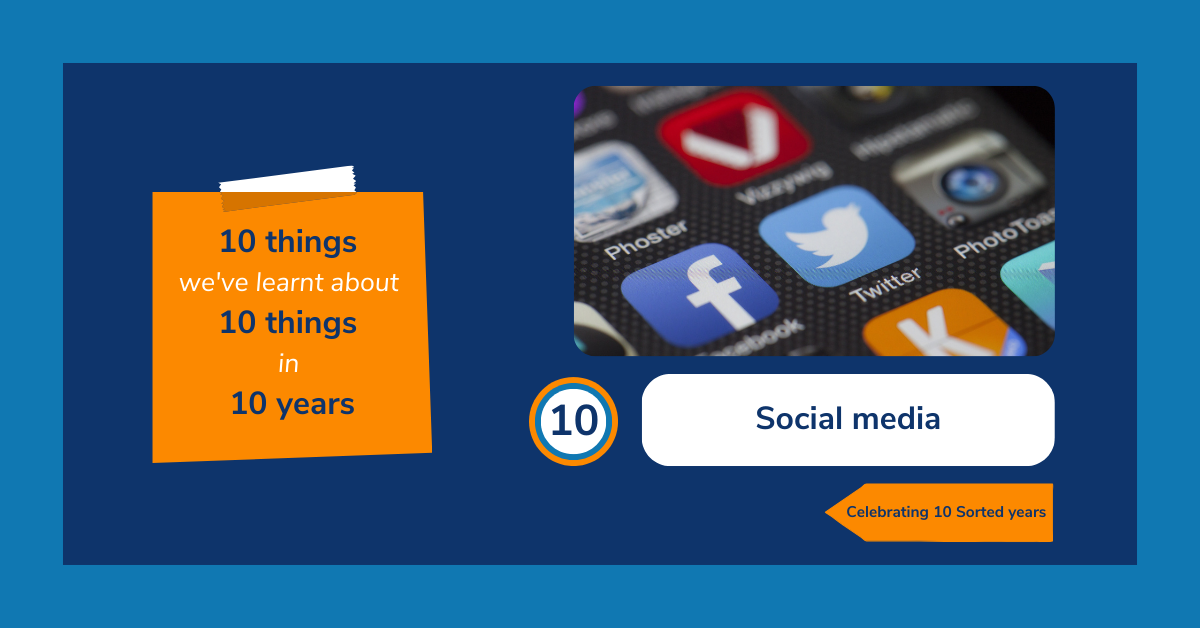Earlier this year we began celebrating our tenth birthday! We’ve been enjoying looking back on the past decade and taking time to take stock of all the things we’ve learnt. As part of this we gave ourselves a challenge to share 10 things we’ve learnt 10 things about in 10 years.
 Over that time, we’ve built up a solid understanding about how best to use social media to engage with audiences, both to promote our work and support our clients in doing the same. It can be a bit of a minefield, but here are our top tips for making the most of your social media accounts:
Over that time, we’ve built up a solid understanding about how best to use social media to engage with audiences, both to promote our work and support our clients in doing the same. It can be a bit of a minefield, but here are our top tips for making the most of your social media accounts:
1. Focus your messaging
Each platform has its own demographic. Facebook, for example, is popular with over 35s, while TikTok mainly attracts 16 to 24-year-old users. This means it’s vital you understand your target market and tailor your content and platform strategy to have the most impact. Focusing your message for your audience and targeting the different platforms appropriately will help you to create higher quality content that is relevant to and actively engages your audience.
2. Choose when you want to post
How regularly you should post depends largely on the platform you’re using. On some, such as Twitter and Instagram stories, you’ll need to be active multiple times throughout the day. If you’re using regular Instagram posts or Facebook updates, they can generally be used more sparingly. Also, think about the context of your content when planning when to share it – for example, if you’re promoting stress relief tips, why not try posting late at night to reach people suffering with insomnia?
3. Keep up with the latest trends
Once you’re up and running, make sure to keep an eye on popular trends on each platform. If you notice something rising in popularity – and it aligns with your brand – then it’s a great idea to jump on the bandwagon to maximise engagement with your audience. However, you should stay wary of creating posts that don’t fit with your overall messaging just to appear relevant.
4. Measure your results
As with every form of comms or marketing activity, to get the best results you need to track and measure your efforts. If that seems like a herculean task, think about choosing a few key measurements that are important to your organisation and brand and measure and track them on a weekly, monthly or quarterly basis. These could include reach and engagement, impressions, click throughs, mentions or views.
5. Test different approaches
There are many different approaches you can test to see what works best with your target audience. A/B testing or split testing, for example, involves using different headlines for the same piece of content to see which generates a better response. So, instead of publishing a tweet or Facebook post once, schedule the post to be shared multiple times and change the headline each time to see if it generates a different result. You could also test posting content at different times of the day or week to see when your audience is most active.
6. Mix up your format
If you have the resources, it can be a really good idea to invest some time and effort in creating content in different formats. In recent years, the popularity of video content has skyrocketed and a tweet containing a video, for example, is significantly more likely to be retweeted than a tweet with a photo or just text.
7. Get involved in communities
Social media communities, such as Facebook groups. Twitter chats and LinkedIn groups continue to grow in importance. They can present a great opportunity to connect with like-minded people or organisations and establish your expertise. You can join and participate in relevant communities or consider starting your own groups and build an audience with shared interests.
8. Interact with your audience
As well as posting engaging, relevant content, make sure you also interact with your audience across the different platforms, so they know there’s a real person on the other side of the computer! This could be promptly answering questions that come up on your posts or getting involved in a conversation between users. Sadly, we all know how social media can bring out the worst in some people, so it’s best practice to build some guidance into your strategy for dealing with criticism and abuse.
9. Don’t take it personally
Social media platforms can be a little sneaky and are well-known for changing their algorithms without notice. Users are often left feeling frustrated at their lack of exposure and it can be tempting to try all sorts of hacks to get round the changes and beat the system as quickly as possible. However, it’s normally a better idea to take time to try and understand what’s changed and make appropriate changes to your content strategy.
10. Make it everyone’s job
Encourage employees from other parts of your organisation to support your social media efforts. That could be anything from contributing to blogs, sharing photos or creating videos that show their part of the organisation. It really isn’t just a job for the social media team – the more involved your wider team is the better.
Have you found this useful? Why not sign up to our newsletter for more guidance, hints and tips and communications insights? Join our newsletter today.
